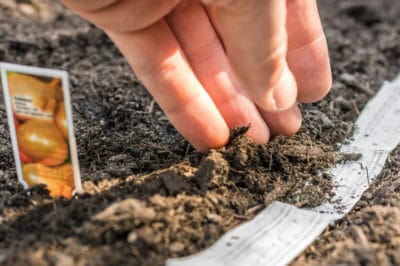Onion Planting Options
You have three options when you decide to plant onions. Each option takes different growth times for harvesting, so keep that in mind when you’re deciding which one to plant. The three choices are planting seeds, transplants or onion sets. The following describes the three ways to plant onions and how long it takes for the onions to reach maturity:
Seeds
Planting onion seeds are the most work and take the longest time before you’ll get mature onion bulbs. You can plant seeds in two ways, either sow them directly in your garden or start the seeds indoors. If you sow them in your garden, add 8 weeks to the onion growing time. Starting your seeds indoors from 4 to 6 weeks before the last frost will cut back on the amount of time it takes until harvest.
If you don’t have enough room in your house, you can start the seeds in a cold frame that located in a sunny outside spot. The cold frame will protect the seedlings from frost damage.
Transplants
Planting onion transplants saves you all the time and effort it takes to plant from seeds. Plant the transplants directly in your garden as soon as you can work the soil and all danger of frost is past. Transplants take about two months to grow into mature onions. If you choose a fast maturing variety, it will take even less time.
Onion Sets
If you live in the north and have a short growing season, the quickest way to have mature onion bulbs is to plant sets. Sets usually produce strong, healthy onions without too much effort. Sets are actually onion bulbs produced for regrowing onions. You can find sets of yellow, red or green onions at any garden center. Plant the sets directly in your garden in the early spring after any danger of frost.
How to Plant Onions
If you live in a cool climate, plant your onions in the late fall or early spring, as long as you’re past any frosts. If you’re in a warm, southern climate, plant your onions in late fall or early winter. Onions love cool weather. Follow these tips for planting your onions:
- Choose a spot that gets sun at least 7 hours per day.
- Turn over the soil and rake out any rocks, roots or weeds.
- Rake the soil until it’s got a smooth, fine texture.
- Use the corner of a hoe to make 1 to 1.5 inch deep furrows in the soil.
- Make the furrows 2 to 3 feet apart.
- Space your transplants or bulbs 3-inches apart in the furrows.
- Cover the bulbs with a thin layer of soil, allowing the onion tops to poke through. If planting transplants, mound the soil around the base of the plant.
- Water the onions, keeping them moist but not saturated.
If you decide to plant seeds directly in your garden, sprinkle them on top of the garden soil. You can cover them with fine soil or hay. Keep the seeds watered and thin out the seedlings when they’re a few inches tall.
Curing and Harvesting Onions
Once your onion tops start to fall over and turn yellow, your onions are mature. When this happens, pull the onion bulbs out of the soil and let them dry out in the garden. It takes from one to two weeks for the onions to cure completely. Keep an eye on the weather because you want your onions to stay dry.
You can move them to a cool, well-ventilated area to continue curing, if there’s rain in the forecast.
Storing Onions
Once your onions cure, store them in bags or containers that have plenty of air circulation. This prevents mold and rot from forming on your onions. Place your packed onions in a dry, cool location that has a temperature from 32ºF (0ºC) to 40ºF (4.4ºC) with 70 percent humidity.
